key CHEVROLET OPTRA 5 2006 1.G Owners Manual
[x] Cancel search | Manufacturer: CHEVROLET, Model Year: 2006, Model line: OPTRA 5, Model: CHEVROLET OPTRA 5 2006 1.GPages: 370, PDF Size: 2.32 MB
Page 1 of 370
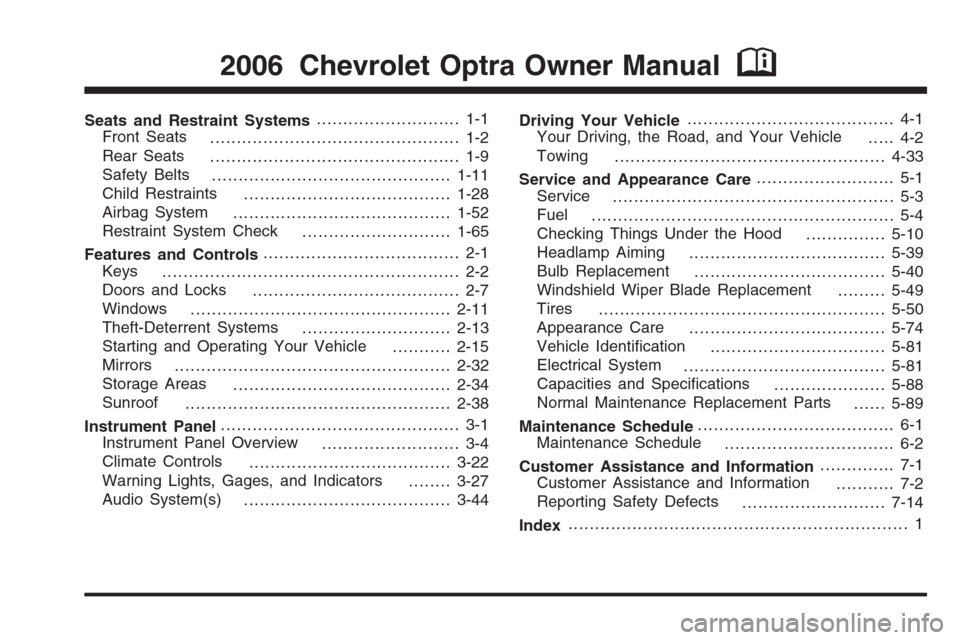
Seats and Restraint Systems........................... 1-1
Front Seats
............................................... 1-2
Rear Seats
............................................... 1-9
Safety Belts
.............................................1-11
Child Restraints
.......................................1-28
Airbag System
.........................................1-52
Restraint System Check
............................1-65
Features and Controls..................................... 2-1
Keys
........................................................ 2-2
Doors and Locks
....................................... 2-7
Windows
.................................................2-11
Theft-Deterrent Systems
............................2-13
Starting and Operating Your Vehicle
...........2-15
Mirrors
....................................................2-32
Storage Areas
.........................................2-34
Sunroof
..................................................2-38
Instrument Panel............................................. 3-1
Instrument Panel Overview
.......................... 3-4
Climate Controls
......................................3-22
Warning Lights, Gages, and Indicators
........3-27
Audio System(s)
.......................................3-44Driving Your Vehicle....................................... 4-1
Your Driving, the Road, and Your Vehicle
..... 4-2
Towing
...................................................4-33
Service and Appearance Care.......................... 5-1
Service
..................................................... 5-3
Fuel
......................................................... 5-4
Checking Things Under the Hood
...............5-10
Headlamp Aiming
.....................................5-39
Bulb Replacement
....................................5-40
Windshield Wiper Blade Replacement
.........5-49
Tires
......................................................5-50
Appearance Care
.....................................5-74
Vehicle Identification
.................................5-81
Electrical System
......................................5-81
Capacities and Specifications
.....................5-88
Normal Maintenance Replacement Parts
......5-89
Maintenance Schedule..................................... 6-1
Maintenance Schedule
................................ 6-2
Customer Assistance and Information.............. 7-1
Customer Assistance and Information
........... 7-2
Reporting Safety Defects
...........................7-14
Index................................................................ 1
2006 Chevrolet Optra Owner ManualM
Page 30 of 370
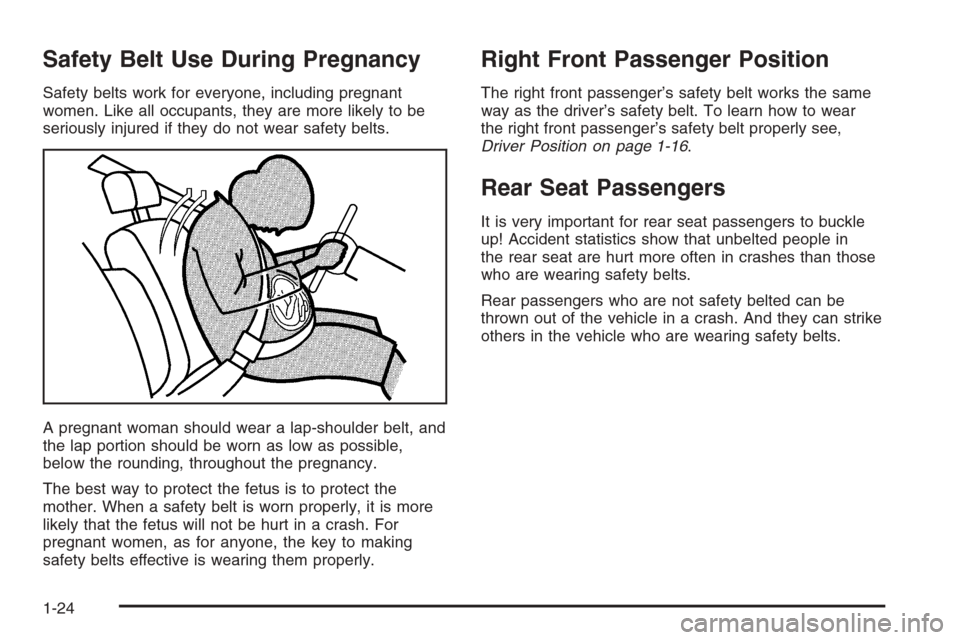
Safety Belt Use During Pregnancy
Safety belts work for everyone, including pregnant
women. Like all occupants, they are more likely to be
seriously injured if they do not wear safety belts.
A pregnant woman should wear a lap-shoulder belt, and
the lap portion should be worn as low as possible,
below the rounding, throughout the pregnancy.
The best way to protect the fetus is to protect the
mother. When a safety belt is worn properly, it is more
likely that the fetus will not be hurt in a crash. For
pregnant women, as for anyone, the key to making
safety belts effective is wearing them properly.
Right Front Passenger Position
The right front passenger’s safety belt works the same
way as the driver’s safety belt. To learn how to wear
the right front passenger’s safety belt properly see,
Driver Position on page 1-16.
Rear Seat Passengers
It is very important for rear seat passengers to buckle
up! Accident statistics show that unbelted people in
the rear seat are hurt more often in crashes than those
who are wearing safety belts.
Rear passengers who are not safety belted can be
thrown out of the vehicle in a crash. And they can strike
others in the vehicle who are wearing safety belts.
1-24
Page 57 of 370
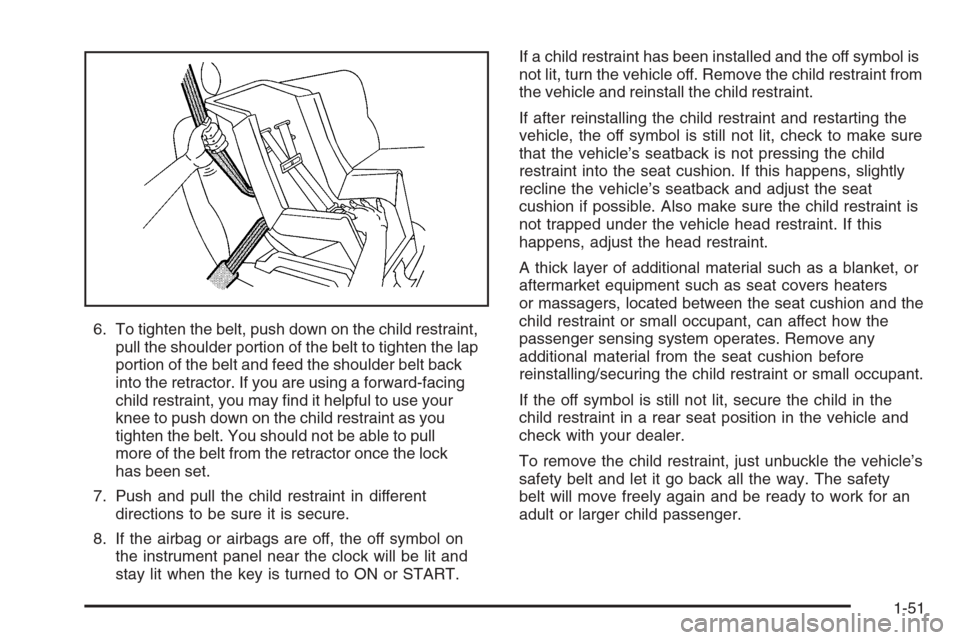
6. To tighten the belt, push down on the child restraint,
pull the shoulder portion of the belt to tighten the lap
portion of the belt and feed the shoulder belt back
into the retractor. If you are using a forward-facing
child restraint, you may find it helpful to use your
knee to push down on the child restraint as you
tighten the belt. You should not be able to pull
more of the belt from the retractor once the lock
has been set.
7. Push and pull the child restraint in different
directions to be sure it is secure.
8. If the airbag or airbags are off, the off symbol on
the instrument panel near the clock will be lit and
stay lit when the key is turned to ON or START.If a child restraint has been installed and the off symbol is
not lit, turn the vehicle off. Remove the child restraint from
the vehicle and reinstall the child restraint.
If after reinstalling the child restraint and restarting the
vehicle, the off symbol is still not lit, check to make sure
that the vehicle’s seatback is not pressing the child
restraint into the seat cushion. If this happens, slightly
recline the vehicle’s seatback and adjust the seat
cushion if possible. Also make sure the child restraint is
not trapped under the vehicle head restraint. If this
happens, adjust the head restraint.
A thick layer of additional material such as a blanket, or
aftermarket equipment such as seat covers heaters
or massagers, located between the seat cushion and the
child restraint or small occupant, can affect how the
passenger sensing system operates. Remove any
additional material from the seat cushion before
reinstalling/securing the child restraint or small occupant.
If the off symbol is still not lit, secure the child in the
child restraint in a rear seat position in the vehicle and
check with your dealer.
To remove the child restraint, just unbuckle the vehicle’s
safety belt and let it go back all the way. The safety
belt will move freely again and be ready to work for an
adult or larger child passenger.
1-51
Page 66 of 370
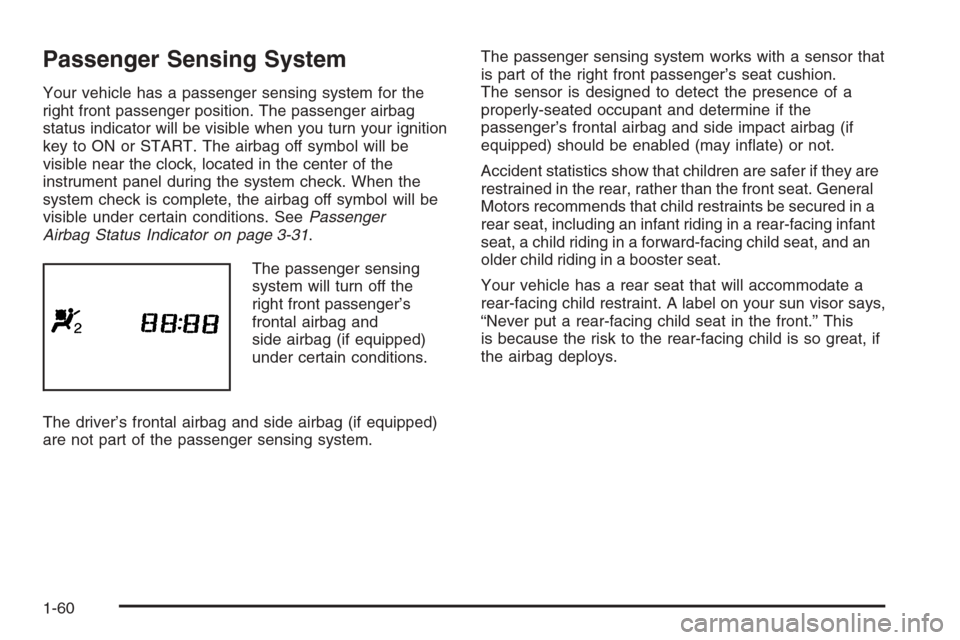
Passenger Sensing System
Your vehicle has a passenger sensing system for the
right front passenger position. The passenger airbag
status indicator will be visible when you turn your ignition
key to ON or START. The airbag off symbol will be
visible near the clock, located in the center of the
instrument panel during the system check. When the
system check is complete, the airbag off symbol will be
visible under certain conditions. SeePassenger
Airbag Status Indicator on page 3-31.
The passenger sensing
system will turn off the
right front passenger’s
frontal airbag and
side airbag (if equipped)
under certain conditions.
The driver’s frontal airbag and side airbag (if equipped)
are not part of the passenger sensing system.The passenger sensing system works with a sensor that
is part of the right front passenger’s seat cushion.
The sensor is designed to detect the presence of a
properly-seated occupant and determine if the
passenger’s frontal airbag and side impact airbag (if
equipped) should be enabled (may inflate) or not.
Accident statistics show that children are safer if they are
restrained in the rear, rather than the front seat. General
Motors recommends that child restraints be secured in a
rear seat, including an infant riding in a rear-facing infant
seat, a child riding in a forward-facing child seat, and an
older child riding in a booster seat.
Your vehicle has a rear seat that will accommodate a
rear-facing child restraint. A label on your sun visor says,
“Never put a rear-facing child seat in the front.” This
is because the risk to the rear-facing child is so great, if
the airbag deploys.
1-60
Page 70 of 370
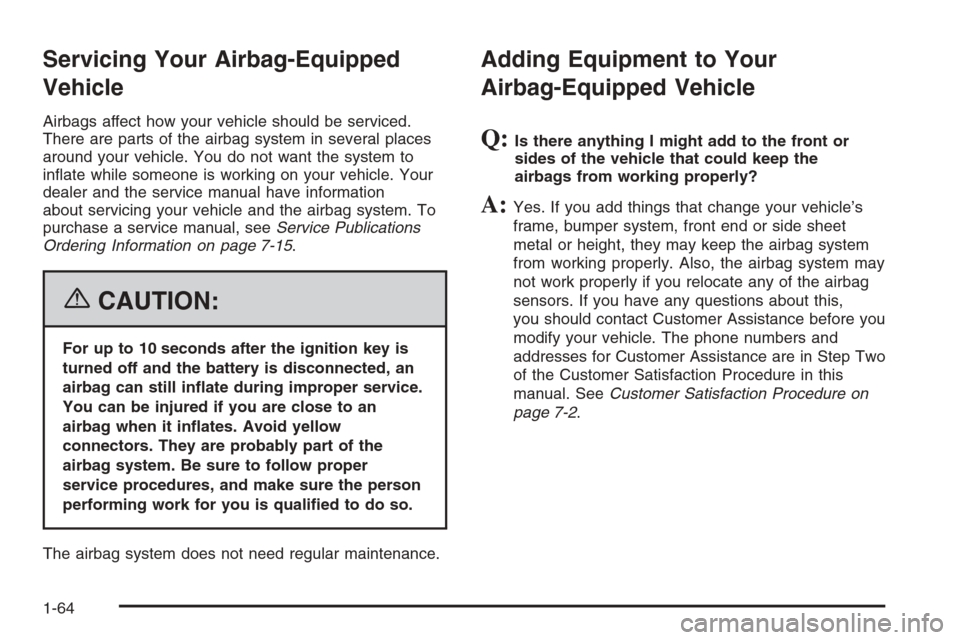
Servicing Your Airbag-Equipped
Vehicle
Airbags affect how your vehicle should be serviced.
There are parts of the airbag system in several places
around your vehicle. You do not want the system to
inflate while someone is working on your vehicle. Your
dealer and the service manual have information
about servicing your vehicle and the airbag system. To
purchase a service manual, seeService Publications
Ordering Information on page 7-15.
{CAUTION:
For up to 10 seconds after the ignition key is
turned off and the battery is disconnected, an
airbag can still in�ate during improper service.
You can be injured if you are close to an
airbag when it in�ates. Avoid yellow
connectors. They are probably part of the
airbag system. Be sure to follow proper
service procedures, and make sure the person
performing work for you is quali�ed to do so.
The airbag system does not need regular maintenance.
Adding Equipment to Your
Airbag-Equipped Vehicle
Q:Is there anything I might add to the front or
sides of the vehicle that could keep the
airbags from working properly?
A:Yes. If you add things that change your vehicle’s
frame, bumper system, front end or side sheet
metal or height, they may keep the airbag system
from working properly. Also, the airbag system may
not work properly if you relocate any of the airbag
sensors. If you have any questions about this,
you should contact Customer Assistance before you
modify your vehicle. The phone numbers and
addresses for Customer Assistance are in Step Two
of the Customer Satisfaction Procedure in this
manual. SeeCustomer Satisfaction Procedure on
page 7-2.
1-64
Page 73 of 370

Keys...............................................................2-2
Remote Keyless Entry System.........................2-3
Remote Keyless Entry System Operation...........2-4
Doors and Locks.............................................2-7
Door Locks....................................................2-7
Central Door Unlocking System........................2-8
Power Door Locks..........................................2-8
Door Ajar Reminder........................................2-8
Rear Door Security Locks................................2-9
Lockout Protection........................................2-10
Liftgate........................................................2-10
Windows........................................................2-11
Manual Windows..........................................2-12
Power Windows............................................2-12
Sun Visors...................................................2-13
Theft-Deterrent Systems..................................2-13
Theft-Deterrent System..................................2-13
Starting and Operating Your Vehicle................2-15
New Vehicle Break-In....................................2-15
Ignition Positions..........................................2-16
Starting the Engine.......................................2-17
Engine Coolant Heater..................................2-19
Automatic Transaxle Operation.......................2-20
Manual Transaxle Operation...........................2-24
Parking Brake..............................................2-25Shifting Into Park (P) (Automatic Transaxle)......2-26
Shifting Out of Park (P) (Automatic Transaxle).....2-28
Parking Your Vehicle (Manual Transaxle).........2-29
Parking Over Things That Burn.......................2-29
Engine Exhaust............................................2-30
Running the Engine While Parked...................2-31
Mirrors...........................................................2-32
Manual Rearview Mirror.................................2-32
Outside Manual Mirrors..................................2-32
Outside Power Mirrors...................................2-33
Outside Convex Mirror...................................2-33
Outside Heated Mirrors..................................2-34
Storage Areas................................................2-34
Glove Box...................................................2-34
Cupholder(s)................................................2-34
Sunglasses Storage Compartment...................2-35
Front Storage Area.......................................2-35
Front Armrest Storage Area...........................2-35
Roof Rack (Wagon Only)...............................2-36
Rear Seat Armrest........................................2-36
Convenience Net..........................................2-36
Cargo Shade (Wagon Only)...........................2-37
Hideaway Rear Storage Bins (Wagon Only)......2-37
Sunroof.........................................................2-38
Section 2 Features and Controls
2-1
Page 74 of 370
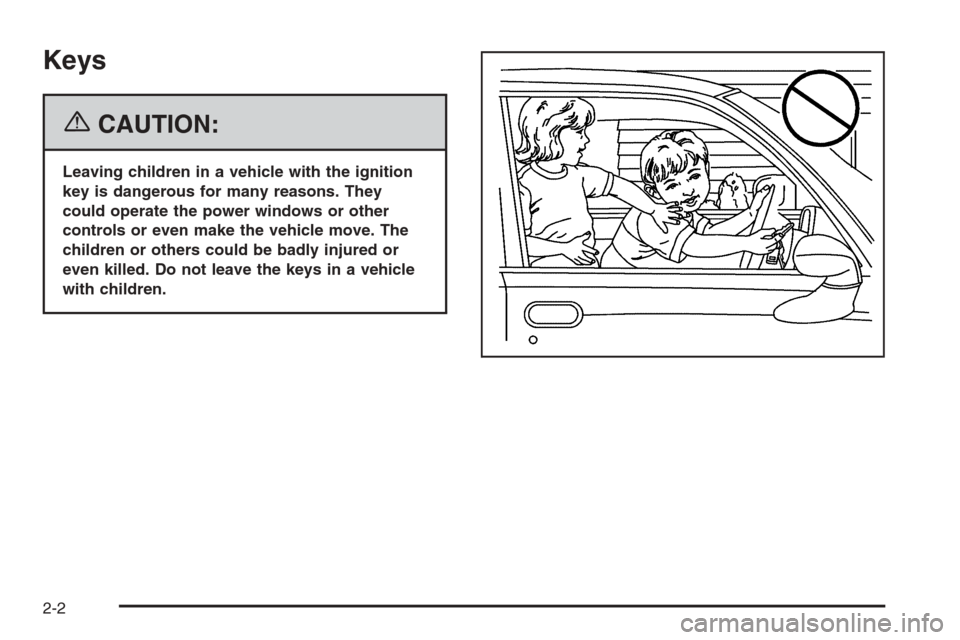
Keys
{CAUTION:
Leaving children in a vehicle with the ignition
key is dangerous for many reasons. They
could operate the power windows or other
controls or even make the vehicle move. The
children or others could be badly injured or
even killed. Do not leave the keys in a vehicle
with children.
2-2
Page 75 of 370
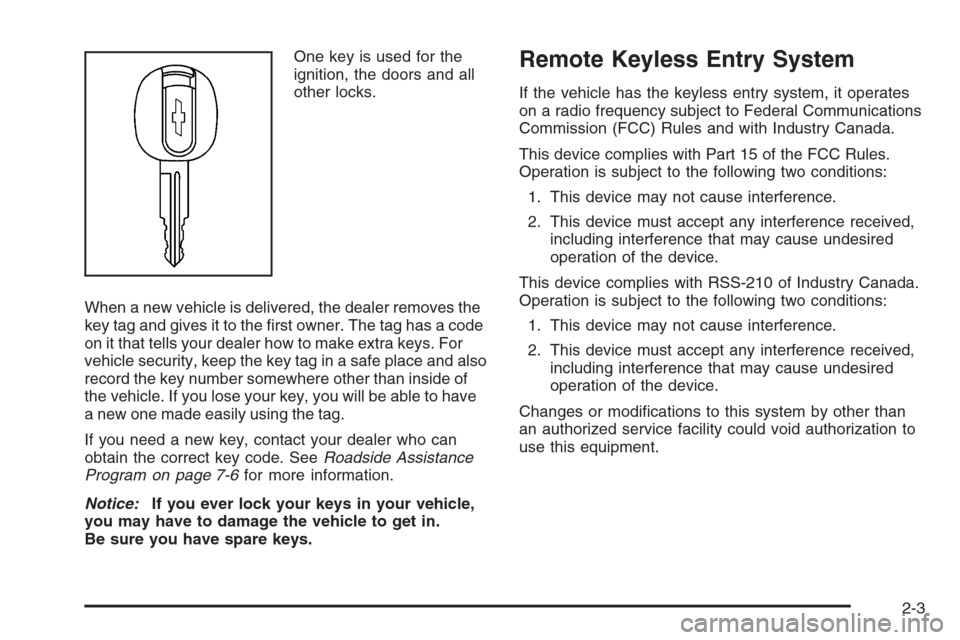
One key is used for the
ignition, the doors and all
other locks.
When a new vehicle is delivered, the dealer removes the
key tag and gives it to the first owner. The tag has a code
on it that tells your dealer how to make extra keys. For
vehicle security, keep the key tag in a safe place and also
record the key number somewhere other than inside of
the vehicle. If you lose your key, you will be able to have
a new one made easily using the tag.
If you need a new key, contact your dealer who can
obtain the correct key code. SeeRoadside Assistance
Program on page 7-6for more information.
Notice:If you ever lock your keys in your vehicle,
you may have to damage the vehicle to get in.
Be sure you have spare keys.Remote Keyless Entry System
If the vehicle has the keyless entry system, it operates
on a radio frequency subject to Federal Communications
Commission (FCC) Rules and with Industry Canada.
This device complies with Part 15 of the FCC Rules.
Operation is subject to the following two conditions:
1. This device may not cause interference.
2. This device must accept any interference received,
including interference that may cause undesired
operation of the device.
This device complies with RSS-210 of Industry Canada.
Operation is subject to the following two conditions:
1. This device may not cause interference.
2. This device must accept any interference received,
including interference that may cause undesired
operation of the device.
Changes or modifications to this system by other than
an authorized service facility could void authorization to
use this equipment.
2-3
Page 76 of 370
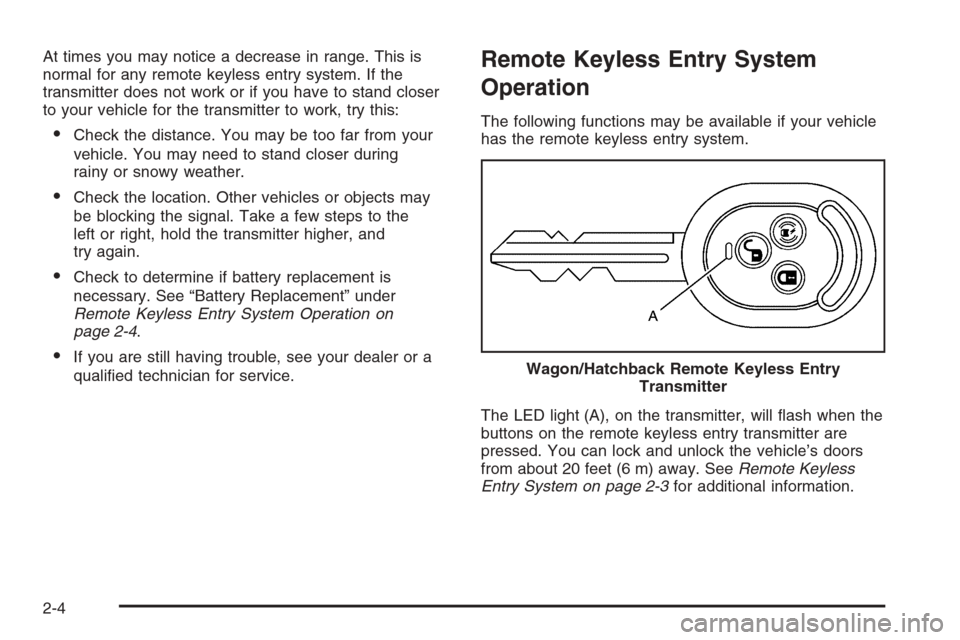
At times you may notice a decrease in range. This is
normal for any remote keyless entry system. If the
transmitter does not work or if you have to stand closer
to your vehicle for the transmitter to work, try this:
•Check the distance. You may be too far from your
vehicle. You may need to stand closer during
rainy or snowy weather.
•Check the location. Other vehicles or objects may
be blocking the signal. Take a few steps to the
left or right, hold the transmitter higher, and
try again.
•Check to determine if battery replacement is
necessary. See “Battery Replacement” under
Remote Keyless Entry System Operation on
page 2-4.
•If you are still having trouble, see your dealer or a
qualified technician for service.
Remote Keyless Entry System
Operation
The following functions may be available if your vehicle
has the remote keyless entry system.
The LED light (A), on the transmitter, will flash when the
buttons on the remote keyless entry transmitter are
pressed. You can lock and unlock the vehicle’s doors
from about 20 feet (6 m) away. SeeRemote Keyless
Entry System on page 2-3for additional information. Wagon/Hatchback Remote Keyless Entry
Transmitter
2-4
Page 77 of 370
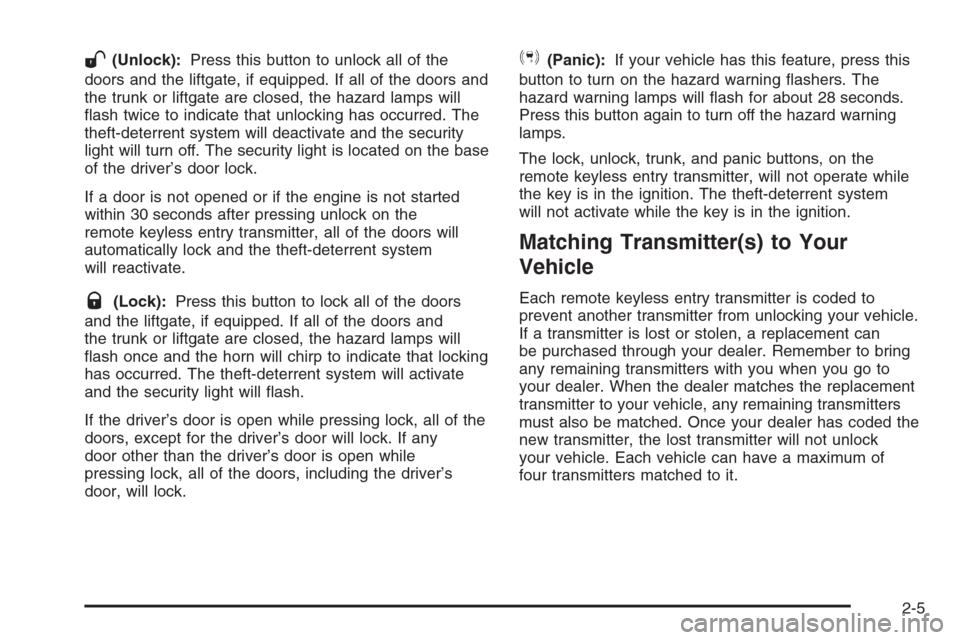
W(Unlock):Press this button to unlock all of the
doors and the liftgate, if equipped. If all of the doors and
the trunk or liftgate are closed, the hazard lamps will
flash twice to indicate that unlocking has occurred. The
theft-deterrent system will deactivate and the security
light will turn off. The security light is located on the base
of the driver’s door lock.
If a door is not opened or if the engine is not started
within 30 seconds after pressing unlock on the
remote keyless entry transmitter, all of the doors will
automatically lock and the theft-deterrent system
will reactivate.
Q(Lock):Press this button to lock all of the doors
and the liftgate, if equipped. If all of the doors and
the trunk or liftgate are closed, the hazard lamps will
flash once and the horn will chirp to indicate that locking
has occurred. The theft-deterrent system will activate
and the security light will flash.
If the driver’s door is open while pressing lock, all of the
doors, except for the driver’s door will lock. If any
door other than the driver’s door is open while
pressing lock, all of the doors, including the driver’s
door, will lock.
S(Panic):If your vehicle has this feature, press this
button to turn on the hazard warning flashers. The
hazard warning lamps will flash for about 28 seconds.
Press this button again to turn off the hazard warning
lamps.
The lock, unlock, trunk, and panic buttons, on the
remote keyless entry transmitter, will not operate while
the key is in the ignition. The theft-deterrent system
will not activate while the key is in the ignition.
Matching Transmitter(s) to Your
Vehicle
Each remote keyless entry transmitter is coded to
prevent another transmitter from unlocking your vehicle.
If a transmitter is lost or stolen, a replacement can
be purchased through your dealer. Remember to bring
any remaining transmitters with you when you go to
your dealer. When the dealer matches the replacement
transmitter to your vehicle, any remaining transmitters
must also be matched. Once your dealer has coded the
new transmitter, the lost transmitter will not unlock
your vehicle. Each vehicle can have a maximum of
four transmitters matched to it.
2-5